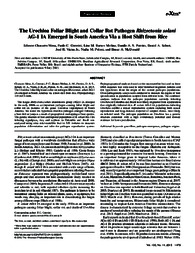The Urochloa foliar blight and collar rot pathogen Rhizoctonia solani AG-1 IA emerged in South America via a host shift from rice.
The Urochloa foliar blight and collar rot pathogen Rhizoctonia solani AG-1 IA emerged in South America via a host shift from rice.
Author(s): MESA, E. C.; CERESINI, P. C.; MOLINA, L. M. R.; PEREIRA, D. A. S.; SCHURT, D. A.; VIEIRA JUNIOR, J. R.; POLONI, N. M.; MCDONALD, B. A.
Summary: The fungus Rhizoctonia solani anastomosis group (AG)-1 IA emerged in the early 1990s as an important pathogen causing foliar blight and collar rot on pastures of the genus Urochloa (signalgrass) in South America. We tested the hypothesis that this pathogen emerged following a host shift or jump as a result of geographical overlapping of host species. The genetic structure of host and regional populations of R. solani AG-1 IA infecting signalgrass, rice, and soybean in Colombia and Brazil was analyzed using nine microsatellite loci in 350 isolates to measure population differentiation and infer the pathogen reproductive system. Phylogeographical analyses based on the microsatellite loci and on three DNA sequence loci were used to infer historical migration patterns and test hypotheses about the origin of the current pathogen populations. Cross pathogenicity assays were conducted to measure the degree of host specialization in populations sampled from different hosts. The combined analyses indicate that the pathogen populations currently infecting Urochloa in Colombia and Brazil most likely originated from a population that originally infected rice. R. solani AG-1 IA populations infecting Urochloa exhibit a mixed reproductive system including both sexual reproduction and long-distance dispersal of adapted clones, most likely on infected seed. The pathogen population on Urochloa has a genetic structure consistent with a high evolutionary potential and showed evidence for host specialization.
Publication year: 2015
Types of publication: Journal article
Unit: Embrapa Rondônia
Keywords: Fungus, Pathogen emergence, Pathogen origins, gene flow
Observation
Some of Embrapa's publications are published as ePub files. To read them, use or download one of the following free software options to your computer or mobile device. Android: Google Play Books; IOS: iBooks; Windows and Linux: Calibre.
Access other publications
Access the Agricultural Research Database (BDPA) to consult Embrapa's full library collection and records.
Visit Embrapa Bookstore to purchase books and other publications sold by Embrapa.

